Classification Performance of a Novel Hydraulic Classifier Equipped with a W-Shaped Reflector
Abstract
:1. Introduction
2. Materials and Methods
2.1. Geometric Modeling and Grid Division
2.2. Boundary Conditions and Solutions Using Numerical Simulations
2.3. Materials
3. Simulation Results and Discussion
Classification Performances of a Classifier Embedded with a W-Shaped Reflector and a Traditional Classifier
4. Experimental Study
4.1. Experimental System
4.2. Classification Performances of the Two Classifiers
4.3. Effects of Structural Dimensions of a W-Shaped Reflector on Classification Performance
5. Conclusions
- (1)
- Differently from a traditional classifier, the new classifier proposed in this paper was set up with a W-shaped reflector at the bottom of the feed port, the purpose of which was to make the slurry re-fold back twice through the reflection of the W-shaped reflector and mix with upwelling water to form an interference settlement, thereby improving the grading accuracy. Through simulation and comparative experiments, it was shown that the W plate classifier was an improvement over the traditional classifier in terms of the yield and grading efficiency.
- (2)
- Compared with the traditional classifier, the tangential speed of the W-shaped classifier increased, while the axial velocity, turbulence kinetic energy, and turbulence dissipation rate decreased. This indicates that the particles were subjected to greater centrifugal force in the W-shaped classifier, the residence time was longer, and the flow field was more stable.
- (3)
- The gap size of the W-shaped reflector and the sorting chamber had a significant impact on the grading efficiency and grading accuracy of the classifier, and the gap being too large or too small adversely affected the grading performance. In this experiment, the bottom miscarriage rate, overflow yield rate, and the grading efficiency of particles of −45 μm were best obtained at a gap of 25 mm. Therefore, a reasonable structural size was conducive to the generation of suspended layers and improved the grading performance.
Author Contributions
Funding
Institutional Review Board Statement
Informed Consent Statement
Data Availability Statement
Conflicts of Interest
References
- Zhu, X.; Liu, J.; Cao, C.; Dong, Y.; Wei, T. Numerical Studies on Teeter Bed Separator for Particle Separation. Energies 2020, 13, 2025. [Google Scholar] [CrossRef] [Green Version]
- Bu, X.N.; Ni, C.; Xie, G.Y.; Peng, Y.L.; Ge, L.H.; Sha, J. Preliminary study on foreign slime for the gravity separation of coarse coal particles in a teeter bed separator. Int. J. Miner. Process. 2017, 160, 76–80. [Google Scholar] [CrossRef]
- Tripathy, A.; Bagchi, S.; Biswal, S.K.; Meikap, B.C. Effect of fin type baffle on the particle hydrodynamics, separation and misplacement in a liquid solid fluidized bed separator. Adv. Powder Technol. 2019, 30, 428–438. [Google Scholar] [CrossRef]
- Laleh, S.; Movahedirad, S.; Sarbanha, A.A.; Sobati, M.A. A new hydraulic particle classifier: Experimental investigation and modeling. Sep. Purif. Technol. 2017, 174, 12–21. [Google Scholar] [CrossRef]
- Mou, X.L.; Jia, F.C.; Fang, Y.; Chen, C.W. CFD-Based Structural Optimization of Rotor Cage for High-Efficiency Rotor Classifier. Processes 2021, 9, 1148. [Google Scholar] [CrossRef]
- Galvin, K.P.; Iveson, S.M.; Zhou, J.; Lowes, C.P. Influence of inclined channel spacing on dense mineral partition in a REFLUX™ Classifier. Part 1: Continuous steady state. Miner. Eng. 2020, 146, 106112. [Google Scholar] [CrossRef]
- Carpenter, J.L.; Iveson, S.M.; Galvin, K.P. Ultrafine desliming using a REFLUX™ classifier subjected to centrifugal G forces. Miner. Eng. 2019, 134, 372–380. [Google Scholar] [CrossRef]
- Jiang, H.S.; Huang, L.; Lu, Q.C.; Zhao, Y.M.; Luo, Z.F.; Duan, C.L.; Dong, L.; Chen, Z.Q.; Lv, B.; Zhao, J.; et al. Separation performance of coal in an air dense medium fluidized bed at varying feeding positions. Fuel 2019, 243, 449–457. [Google Scholar] [CrossRef]
- Zhang, Y.S.; Zhang, L.; Liu, Y.Y.; Shi, C.C.; Wang, F.L. Experimental study of separation teston hindered pulsating teetered bed separator. Coal. Prep. Technol. 2013, 3, 17–20. [Google Scholar] [CrossRef]
- Yang, L.; Chen, J.T.; Zhang, L. Research on Feed Range of Teetered Bed Separator and Simulation. Coal. Prep. Technol. 2014, 33, 329–331. [Google Scholar] [CrossRef]
- Wei, L.B.; Liu, J.L. Coarse slime separation and numerical simulationof a new liquid-solid fluidized bed. J. Chin. Univ. Min. Technol. 2019, 48, 882–888. [Google Scholar] [CrossRef]
- Chen, K.; Bachmann, P.; Bück, A.; Jacob, M.; Tsotsas, E. CFD simulation of particle residence time distribution in industrial scale horizontal fluidized bed. Powder Technol. 2019, 345, 129–139. [Google Scholar] [CrossRef]
- Sun, Z.; Liang, L.; Liu, Q.; Yu, X. Effect of the particle injection position on the performance of a cyclonic gas solids classifier. Adv. Powder Technol. 2020, 31, 227–233. [Google Scholar] [CrossRef]
- Wang, K.B.; Li, Y.F.; Zhang, X.B.; He, C.Y.; Yu, Y.Y. Structural designand experimental study of liquid-solid fluidized bed for three products. Coal. Eng. 2014, 46, 115–118. [Google Scholar] [CrossRef]
- Zhang, X.B.; Li, Y.F.; Wang, K.B.; He, C.Y.; Yu, Y.Y. Study on Liquid Solid Fluidized Bed Applied to Tailings Repreparation. Coal. Eng. 2014, 46, 111–113. [Google Scholar] [CrossRef]
- Jayarathna, C.K.; Balfe, M.; Moldestad, B.M.E.; Tokheim, L.-A. Improved multi-stage cross-flow fluidized bed classifier. Powder Technol. 2019, 342, 621–629. [Google Scholar] [CrossRef]
- Galvin, K.P.; Nguyentranlam, G. Influence of parallel inclined plates in a liquid fluidized bed system. Chem. Eng. Sci. 2002, 57, 1231–1234. [Google Scholar] [CrossRef]
- Galvin, K.P.; Doroodchi, E.; Callen, A.M.; Lambert, N.; Pratten, S.J. Pilot plant trial of the reflux classifier. Miner. Eng. 2002, 15, 19–25. [Google Scholar] [CrossRef]
- Bondarenko, A.O. Modeling of interaction of inclined surfaces of a hydraulic classifier with a flow of solid particles. Sci. Bul. Nat. Min. Univ. 2018, 4, 13–20. [Google Scholar] [CrossRef] [Green Version]
- Zhang, Y.K.; Cao, J.Z.; Liu, P.K.; Li, X.Y.; Yang, Y.H.; Wang, H. Performance analysis of a new teetered bed separator with W-type reflector. J. Min. Saf. Eng. 2020, 37, 207–214. [Google Scholar] [CrossRef]
- Zhang, Y.K.; Cao, J.Z.; Liu, P.K.; Yang, M.; Zheng, X.F. Numerical Simulation and Experimental Study of New Hydraulic Classifier. Met. Mine 2019, 6, 168–172. [Google Scholar] [CrossRef]
- Zhang, X.D.; Fan, M.Q. Development and test study on a new type of separation classifier. Chin. Min. Mag. 2016, 25, 159–163. [Google Scholar] [CrossRef]
- Yang, X.; Yang, G.; Liu, P.; Li, X.; Jiang, L.; Zhang, J. Study on the Desliming Performance of a Novel Hydrocyclone Sand Washer. Separations 2022, 9, 74. [Google Scholar] [CrossRef]
- Yi, H.-W.; Kwon, J.-Y.; Lee, Y.-W.; Kang, M.-C. Optimization of the Outlet Flow Ratio of Mini-Hydrocyclone Separators Using the Full Factorial Design Method to Determine the Separation Efficiency. Separations 2021, 8, 210. [Google Scholar] [CrossRef]
- Galletti, C.; Rum, A.; Turchi, V.; Nicolella, C. Numerical analysis of flow field and particle motion in a dynamic cyclonic selector. Adv. Powder Technol. 2020, 31, 1264–1273. [Google Scholar] [CrossRef]
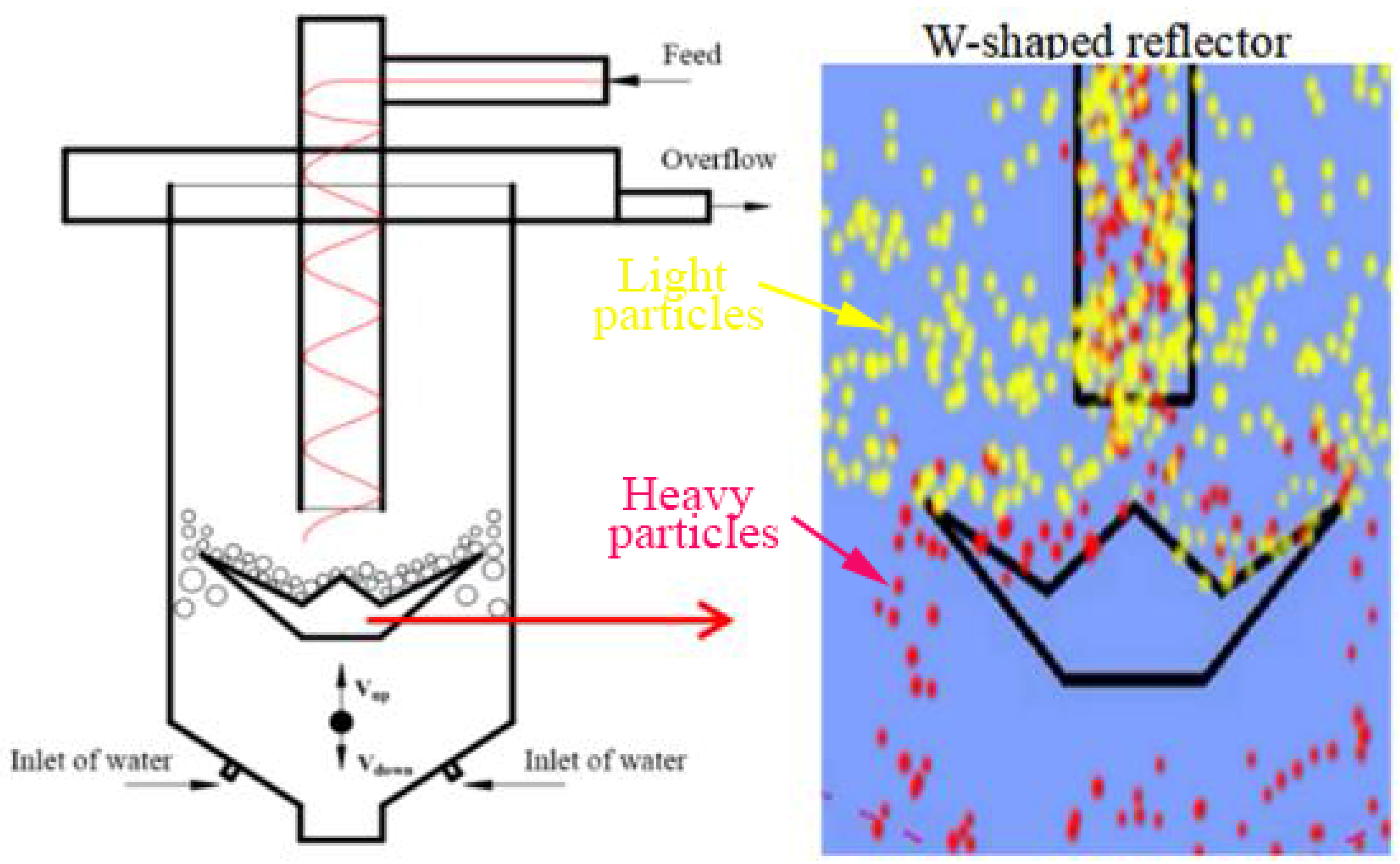
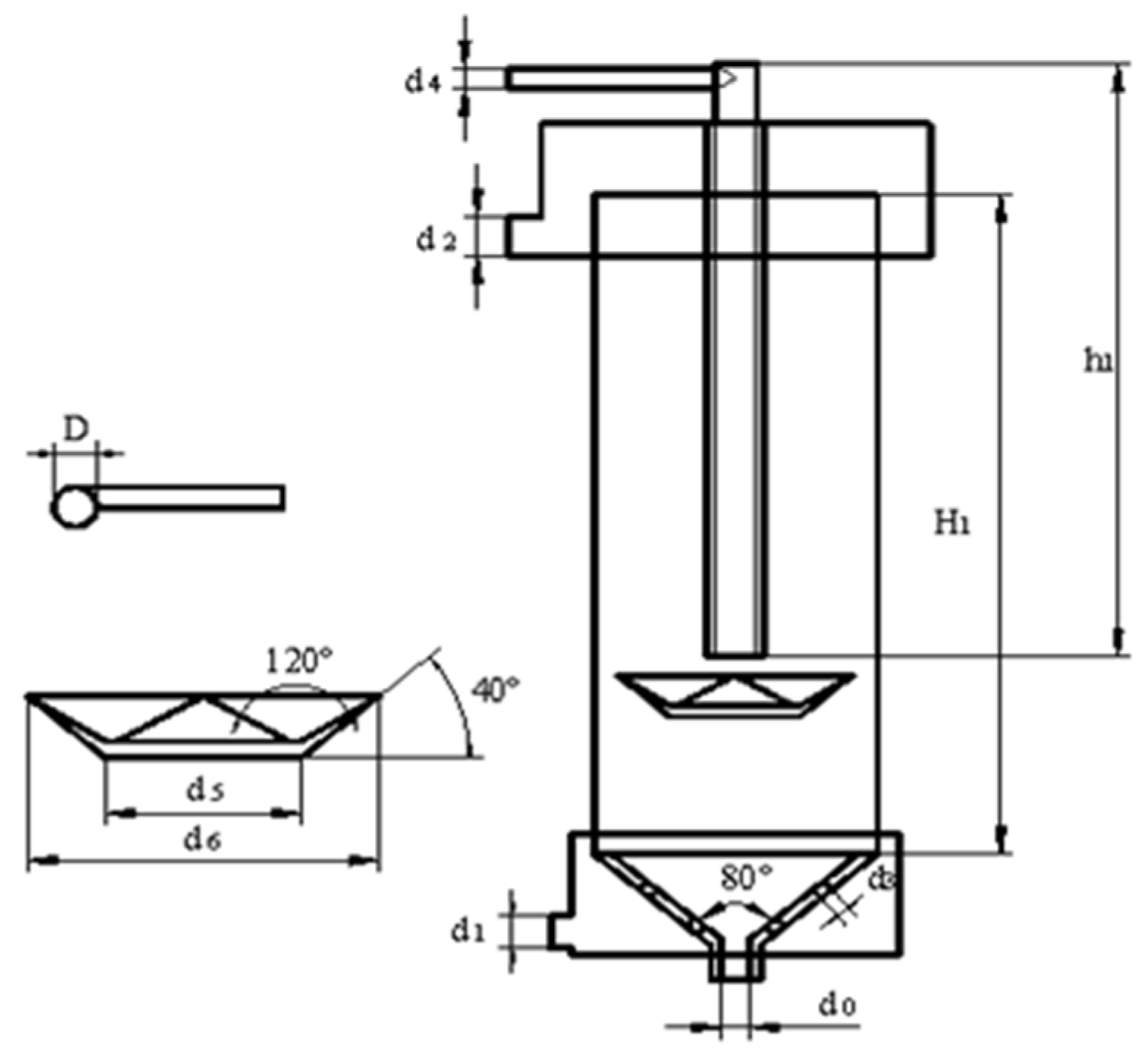
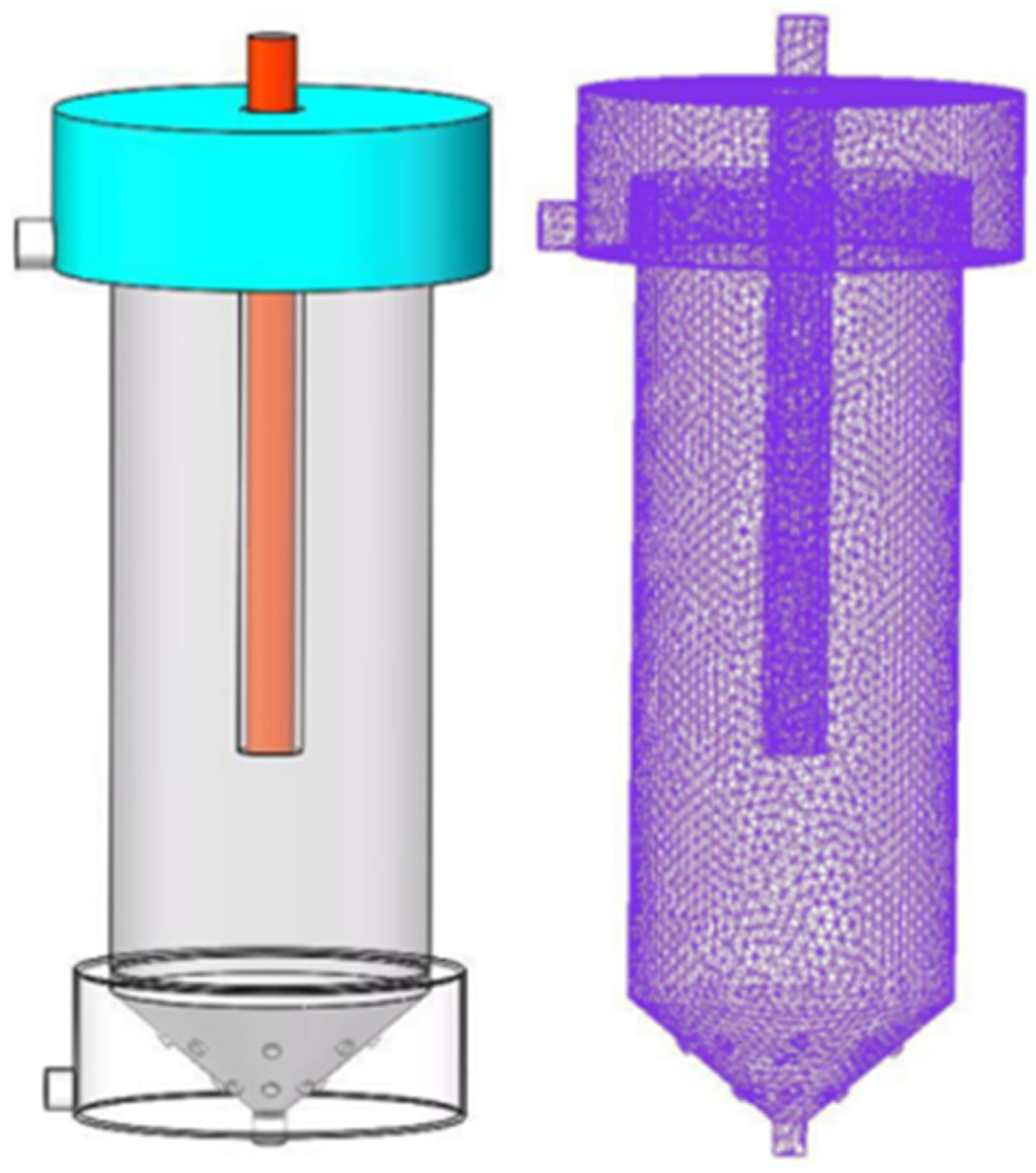
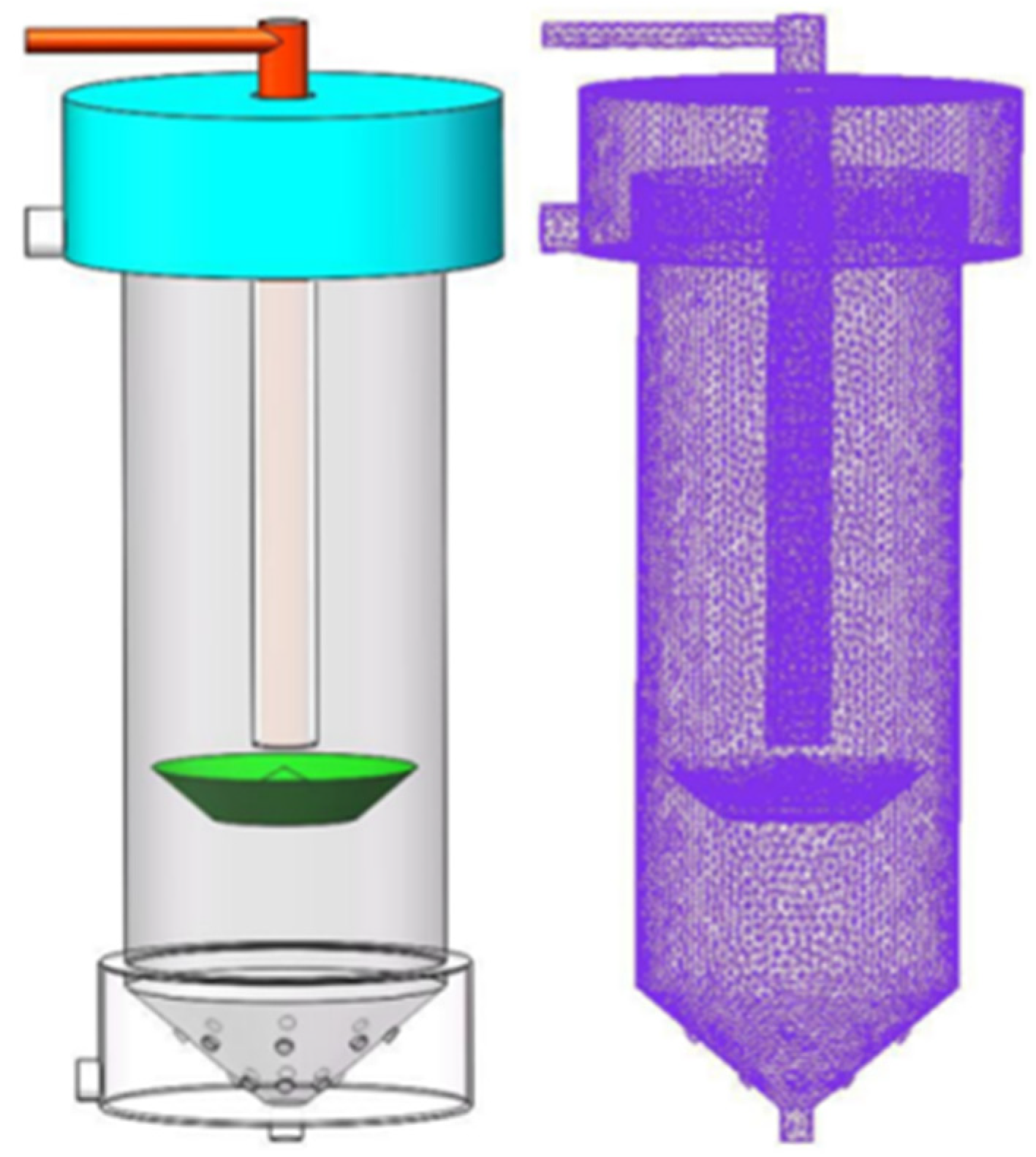


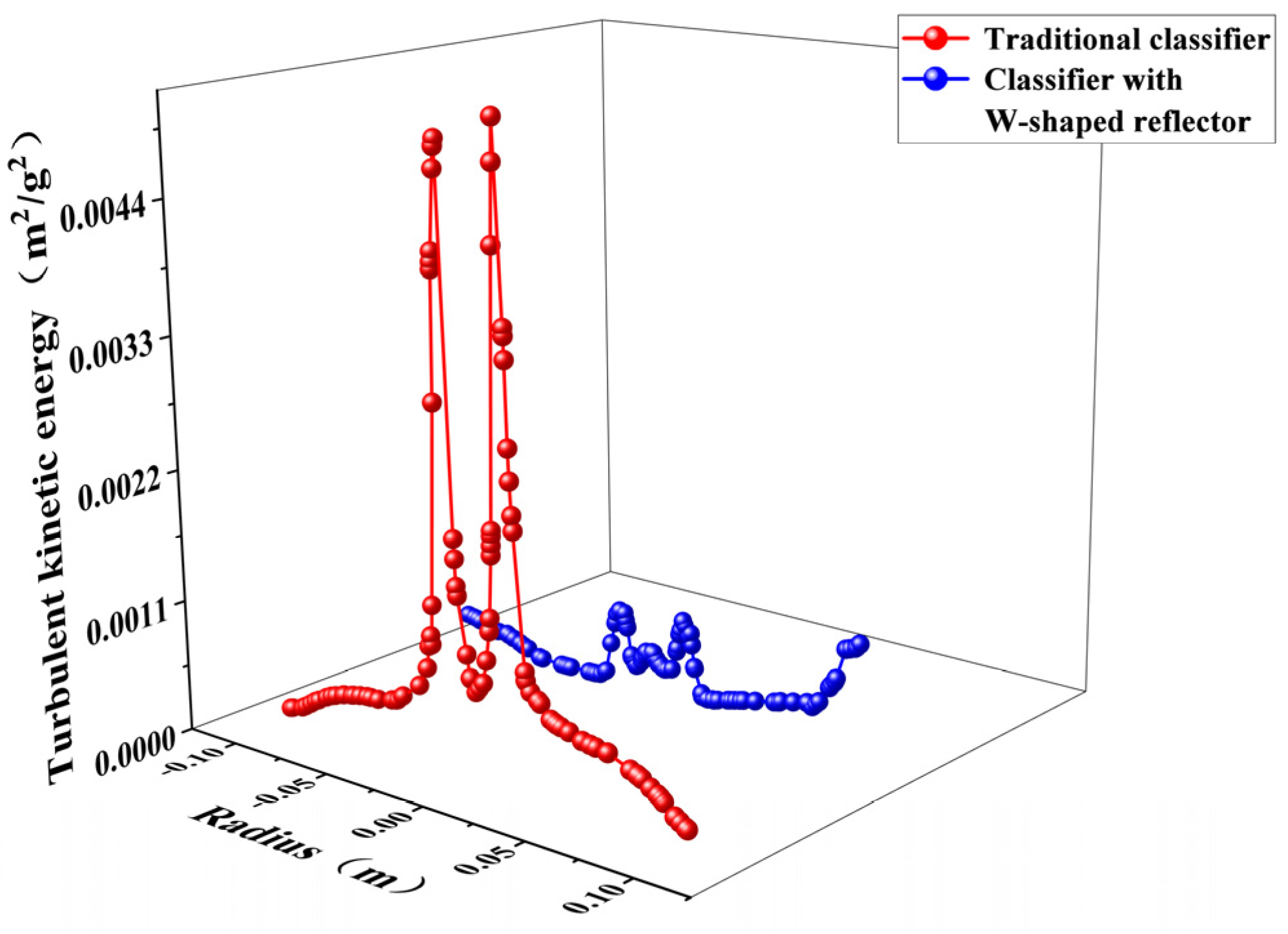
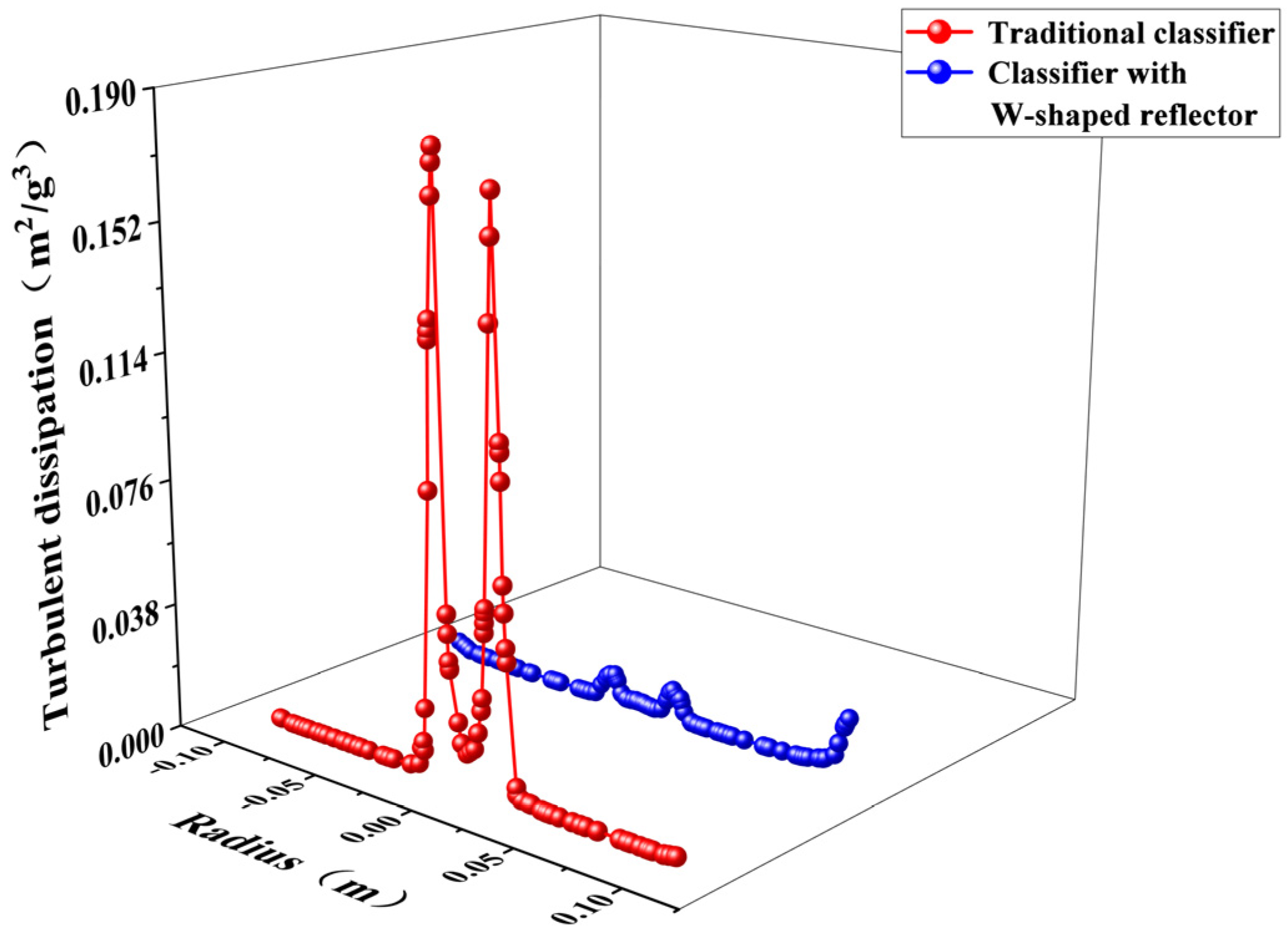

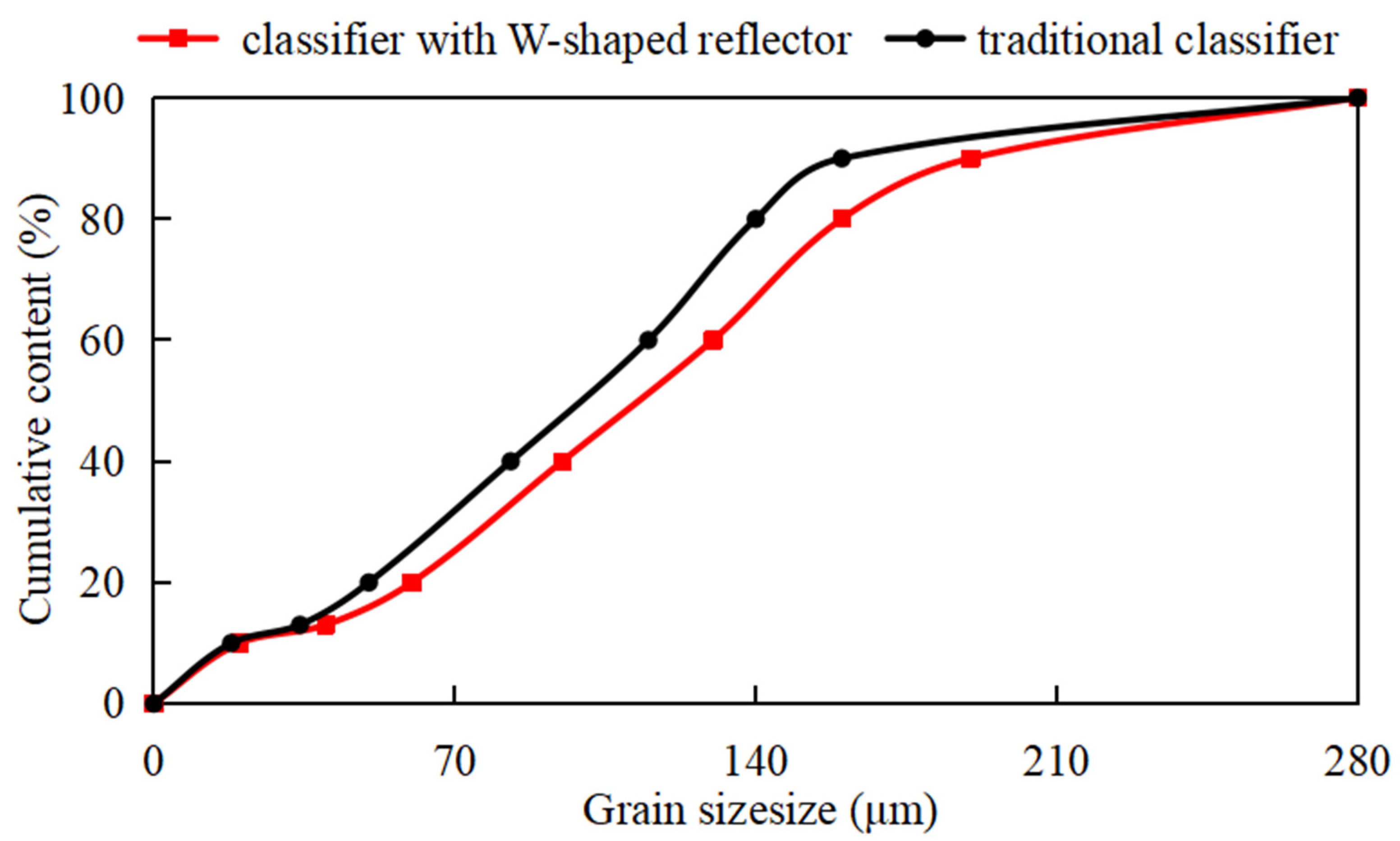



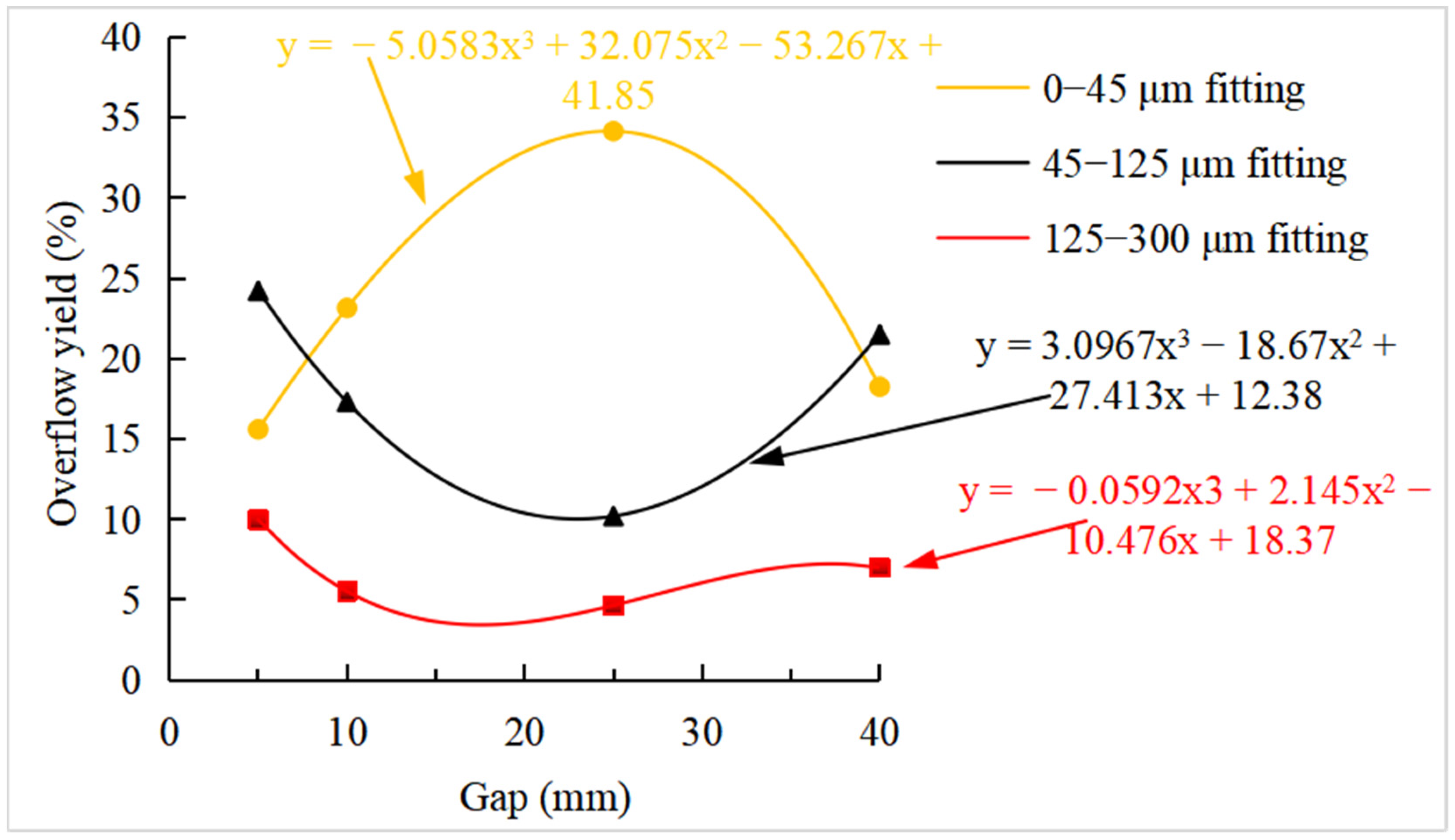

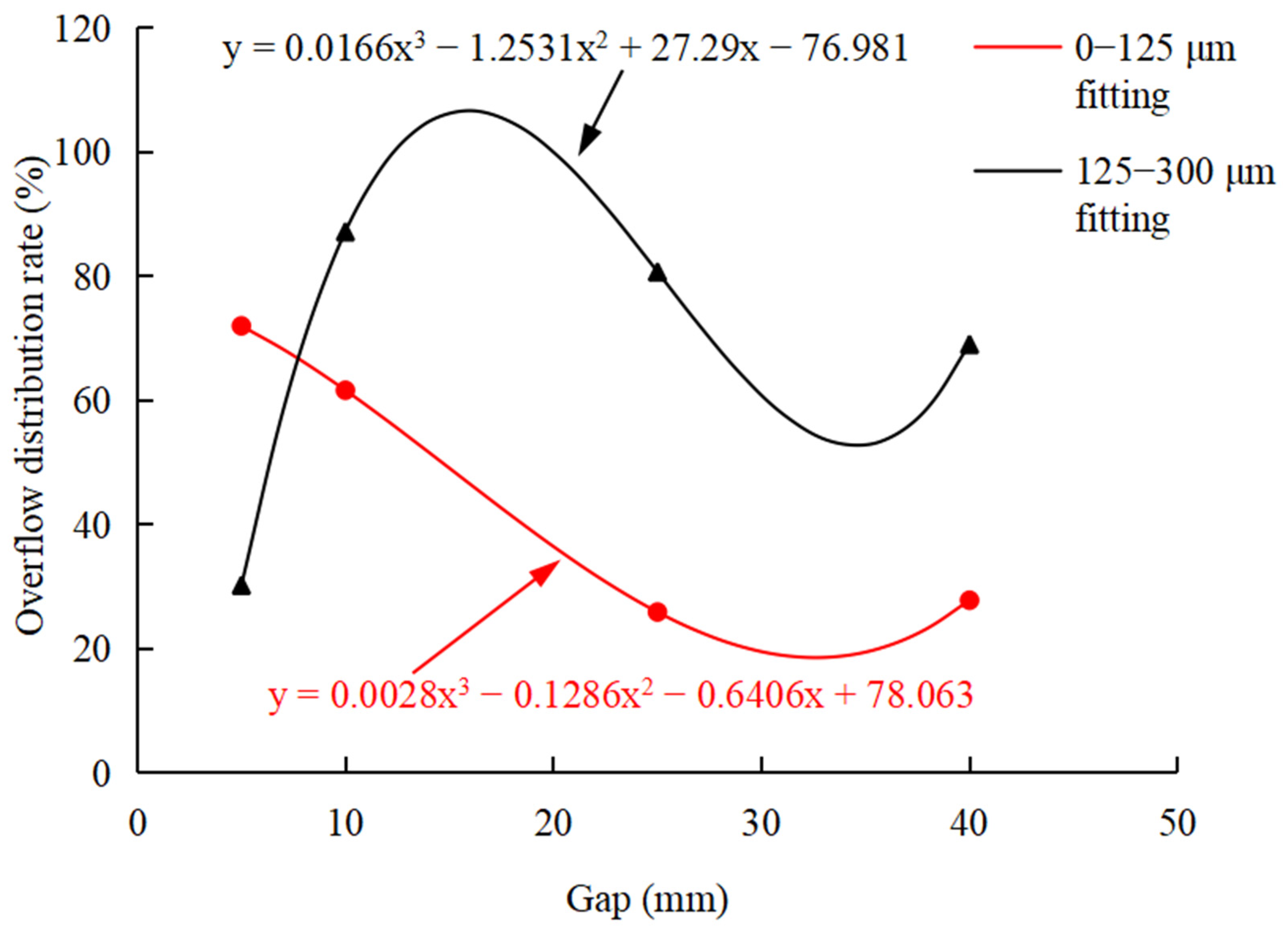
| Structure | Value | Structure | Value |
|---|---|---|---|
| Length of feed pipe h1 (mm) | 550 | Diameter of overflow inlet d2 (mm) | 30 |
| Length of classification cavity H1 (mm) | 500 | Diameter of water inlet d3 (mm) | 4 |
| Diameter of feed pipe D (mm) | 30 | Diameter of tangential inlet d4 (mm) | 15 |
| Diameter of underflow inlet do (mm) | 20 | Diameter of reflector bottom d5 (mm) | 90 |
| Diameter of water inlet bin d1 (mm) | 20 | Diameter of reflector top d6 (mm) | 165 |
| Particle Size (μm) | Interval Content (%) | Accumulated Content (%) |
|---|---|---|
| 0–15 | 1.32 | 1.32 |
| 15–30 | 5.63 | 6.95 |
| 30–45 | 15.15 | 22.1 |
| 45–75 | 16.35 | 38.45 |
| 75–90 | 13.34 | 51.79 |
| 90–125 | 19.51 | 71.3 |
| 125–150 | 9.61 | 80.91 |
| 150–180 | 6.35 | 87.26 |
| 180–212 | 5.24 | 92.5 |
| 212–250 | 3.26 | 95.76 |
| 250–300 | 4.24 | 100 |
| Size Range | Traditional Classifier | Classifier with W-Shaped Reflector | |||
|---|---|---|---|---|---|
| Underflow | Overflow | Underflow | Overflow | ||
| Content (%) | 60.32 | 8.32 | 62.35 | 9.21 | |
| Productivity (%) | 0–45 μm | 8.35 | 24.21 | 4.68 | 30.24 |
| 45–125 μm | 11.62 | 16.83 | 10.37 | 14.36 | |
| 125–300 μm | 25.34 | 13.65 | 31.69 | 8.66 | |
| Yield (%) | 13.68 | 86.32 | 11.35 | 88.68 | |
| Classifier | The Content of 100–125 μm Particles/% | Classification Efficiency/% | ||
|---|---|---|---|---|
| Feed | Overflow | Underflow | ||
| Traditional classifier | 71.3 | 90.62 | 45.32 | 54.14 |
| Classifier embedded with a W-shaped reflector | 71.3 | 95.34 | 41.18 | 65.33 |
Publisher’s Note: MDPI stays neutral with regard to jurisdictional claims in published maps and institutional affiliations. |
© 2022 by the authors. Licensee MDPI, Basel, Switzerland. This article is an open access article distributed under the terms and conditions of the Creative Commons Attribution (CC BY) license (https://creativecommons.org/licenses/by/4.0/).
Share and Cite
Zhang, Y.; Duan, Y.; Jiang, L.; Cao, J. Classification Performance of a Novel Hydraulic Classifier Equipped with a W-Shaped Reflector. Separations 2022, 9, 212. https://doi.org/10.3390/separations9080212
Zhang Y, Duan Y, Jiang L, Cao J. Classification Performance of a Novel Hydraulic Classifier Equipped with a W-Shaped Reflector. Separations. 2022; 9(8):212. https://doi.org/10.3390/separations9080212
Chicago/Turabian StyleZhang, Yuekan, Yaoxu Duan, Lanyue Jiang, and Jingzhen Cao. 2022. "Classification Performance of a Novel Hydraulic Classifier Equipped with a W-Shaped Reflector" Separations 9, no. 8: 212. https://doi.org/10.3390/separations9080212
APA StyleZhang, Y., Duan, Y., Jiang, L., & Cao, J. (2022). Classification Performance of a Novel Hydraulic Classifier Equipped with a W-Shaped Reflector. Separations, 9(8), 212. https://doi.org/10.3390/separations9080212






